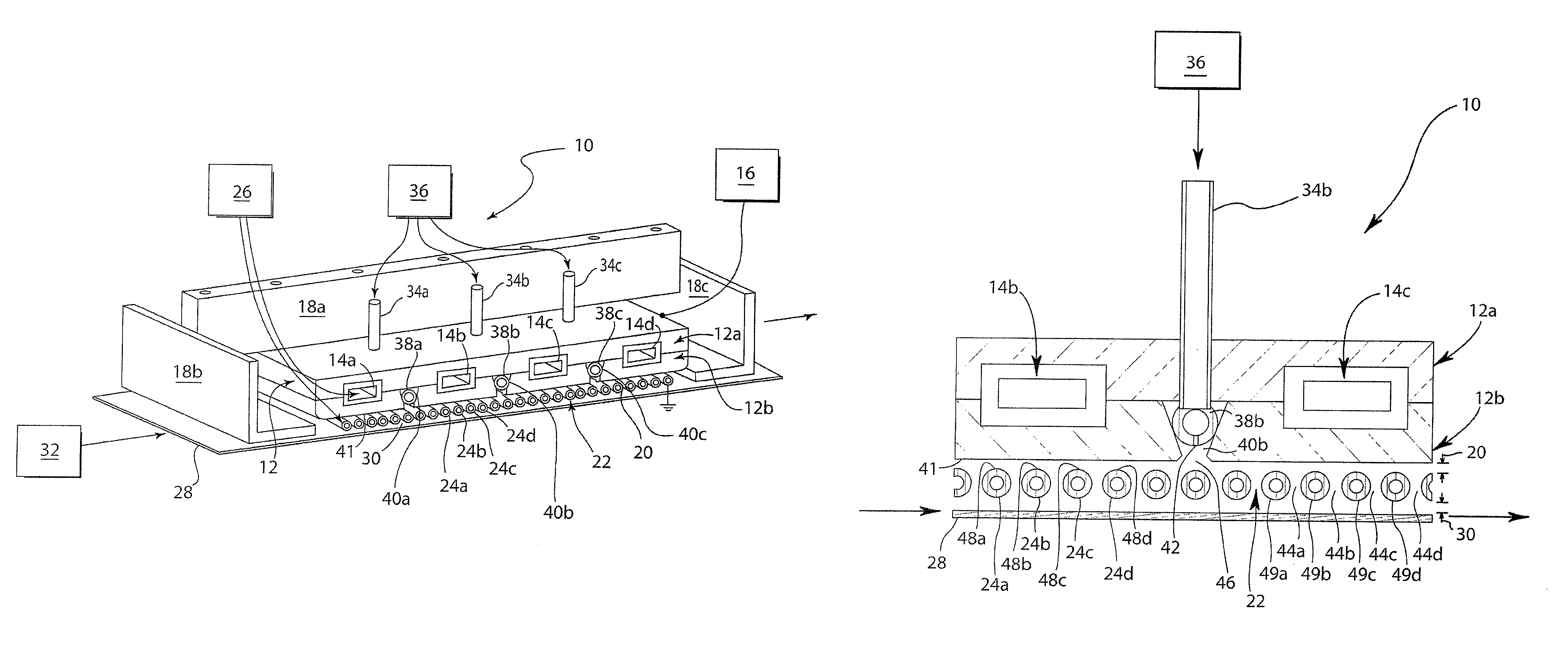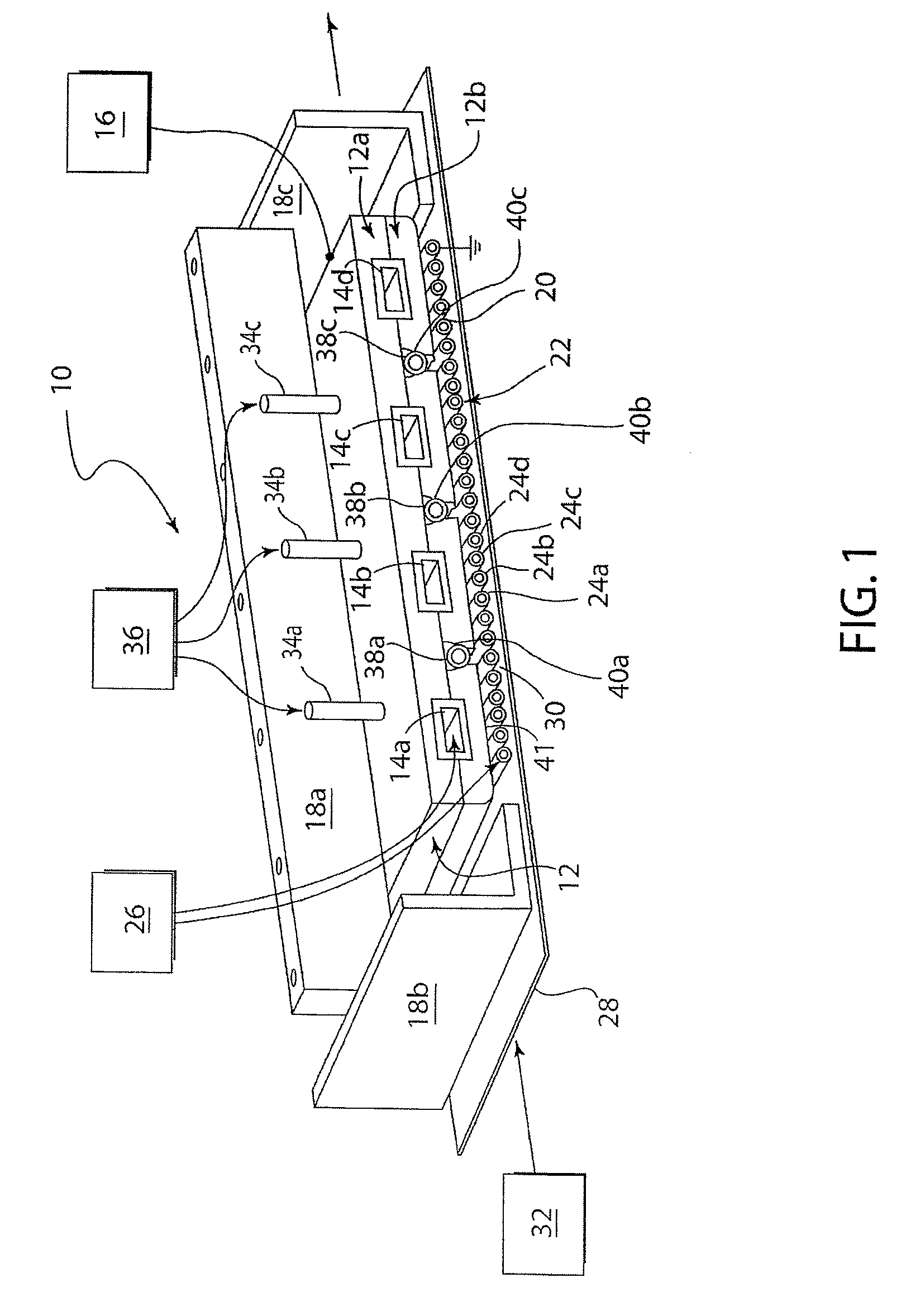Large area, atmospheric pressure plasma for downstream processing
a technology of atmospheric pressure and plasma, applied in the direction of plasma technique, electric discharge lamp, coating, etc., can solve the problems of limited plasma use for treatment of commercially important substrates, complicated plasma treatment of these substrates using vacuum-based plasma, dangerous and prohibitively expensive, etc., to achieve rapid polymerization of monomer, uniform surface processing, and good results
- Summary
- Abstract
- Description
- Claims
- Application Information
AI Technical Summary
Benefits of technology
Problems solved by technology
Method used
Image
Examples
example 1
[0050]A polyester fabric having a thickness of 0.7 mm. was mounted on a movable, temperature-controlled stage, the temperature set at 15° C., and the fabric plasma-treated for water and oil repellence (hydrophobicity and oleophobicity) in accordance with the teachings of the patent application Ser. No. 11 / 556,130, supra. The gap between the applicator and the stage was 3.5 mm; the gap between the planar rf electrode and the top of the ground electrode was 2.0 mm; the grounded, water-cooled, parallel, aluminum tubes, ¼ in. O.D. had a spacing between the tubes of 0.09 in.; and the gap between the bottom of the ground electrode and the stage was 5.2 mm. The argon flow into the evaporator / applicator was 0.3 slpm, and the chemical feed rate of perfluorooctylacrylate-based monomer (Daikin TG-10) was 0.6 ml / min. The temperature of the evaporator was 170° C. and that for the applicator was 180° C. The plasma was operated at 650 W at 13.56 MHz using a constant flow of 40 slpm of He, to which...
example 2
[0054]A similar sample to that described in EXAMPLE 1 hereof was mounted on a movable, temperature-controlled stage, the temperature set at 15° C., and plasma-treated for water and oil repellence (hydrophobicity and oleophobicity) in accordance with the teachings of the patent application Ser. No. 11 / 556,130, supra. The distance between the applicator and the stage surface to which the fabric was mounted was 3.5 mm; the gaps between the planar rf electrode and the tops of the ¼ in. O.D. tubular, aluminum grounded electrodes were 2.0 mm; and the gap between the bottom of the tubular ground electrode and the stage was 2.5 mm. The argon flow through the evaporator / applicator was 0.3 slpm; the total flow through the three gas distribution tubes connected to the 12 in.×5 in. rf electrode was comprised of 40 slpm He+0.04 slpm of NH3; the applied rf power was 700 W at 13.56 MHz. The stage speed was 3.3 yd / min., and a perfluorooctylacrylate-based monomer (Daikin TG-10) was applied at a flow...
example 3
[0056]A transparent, 0.05 mm thick polypropylene film was mounted on a movable, temperature-controlled stage, the temperature set at 15° C., and a thinly-condensed film of liquid methylmethacrylate (MMA) monomer was applied to the surface facing the downstream plasma at a flow rate of 0.4 ml / min., in accordance with the teachings of the U.S. patent application Ser. No. 11 / 556,130, supra. The argon flowrate through the evaporator / applicator was 0.3 slpm, the distance between the applicator and the stage surface to which the film was mounted was 3.0 mm, the temperature of the evaporator was 95° C., and that for the applicator was 100° C.
[0057]In the plasma discharge apparatus of the present invention, both the gaps between the planar rf electrode and the closest locations of the surfaces of the ¼ in. O.D. tubular, aluminum grounded electrodes thereto, and the spacings between the surfaces of the tubular electrodes were 2.0 mm; and the gaps between the closest locations of the surfaces...
PUM
| Property | Measurement | Unit |
|---|---|---|
| temperature | aaaaa | aaaaa |
| gas temperature | aaaaa | aaaaa |
| temperatures | aaaaa | aaaaa |
Abstract
Description
Claims
Application Information
 Login to View More
Login to View More - R&D
- Intellectual Property
- Life Sciences
- Materials
- Tech Scout
- Unparalleled Data Quality
- Higher Quality Content
- 60% Fewer Hallucinations
Browse by: Latest US Patents, China's latest patents, Technical Efficacy Thesaurus, Application Domain, Technology Topic, Popular Technical Reports.
© 2025 PatSnap. All rights reserved.Legal|Privacy policy|Modern Slavery Act Transparency Statement|Sitemap|About US| Contact US: help@patsnap.com



